Sreyas Mohan
Steepest Descent Density Control for Compact 3D Gaussian Splatting
May 08, 2025Abstract:3D Gaussian Splatting (3DGS) has emerged as a powerful technique for real-time, high-resolution novel view synthesis. By representing scenes as a mixture of Gaussian primitives, 3DGS leverages GPU rasterization pipelines for efficient rendering and reconstruction. To optimize scene coverage and capture fine details, 3DGS employs a densification algorithm to generate additional points. However, this process often leads to redundant point clouds, resulting in excessive memory usage, slower performance, and substantial storage demands - posing significant challenges for deployment on resource-constrained devices. To address this limitation, we propose a theoretical framework that demystifies and improves density control in 3DGS. Our analysis reveals that splitting is crucial for escaping saddle points. Through an optimization-theoretic approach, we establish the necessary conditions for densification, determine the minimal number of offspring Gaussians, identify the optimal parameter update direction, and provide an analytical solution for normalizing off-spring opacity. Building on these insights, we introduce SteepGS, incorporating steepest density control, a principled strategy that minimizes loss while maintaining a compact point cloud. SteepGS achieves a ~50% reduction in Gaussian points without compromising rendering quality, significantly enhancing both efficiency and scalability.
InteractAvatar: Modeling Hand-Face Interaction in Photorealistic Avatars with Deformable Gaussians
Apr 10, 2025Abstract:With the rising interest from the community in digital avatars coupled with the importance of expressions and gestures in communication, modeling natural avatar behavior remains an important challenge across many industries such as teleconferencing, gaming, and AR/VR. Human hands are the primary tool for interacting with the environment and essential for realistic human behavior modeling, yet existing 3D hand and head avatar models often overlook the crucial aspect of hand-body interactions, such as between hand and face. We present InteracttAvatar, the first model to faithfully capture the photorealistic appearance of dynamic hand and non-rigid hand-face interactions. Our novel Dynamic Gaussian Hand model, combining template model and 3D Gaussian Splatting as well as a dynamic refinement module, captures pose-dependent change, e.g. the fine wrinkles and complex shadows that occur during articulation. Importantly, our hand-face interaction module models the subtle geometry and appearance dynamics that underlie common gestures. Through experiments of novel view synthesis, self reenactment and cross-identity reenactment, we demonstrate that InteracttAvatar can reconstruct hand and hand-face interactions from monocular or multiview videos with high-fidelity details and be animated with novel poses.
WaSt-3D: Wasserstein-2 Distance for Scene-to-Scene Stylization on 3D Gaussians
Sep 26, 2024



Abstract:While style transfer techniques have been well-developed for 2D image stylization, the extension of these methods to 3D scenes remains relatively unexplored. Existing approaches demonstrate proficiency in transferring colors and textures but often struggle with replicating the geometry of the scenes. In our work, we leverage an explicit Gaussian Splatting (GS) representation and directly match the distributions of Gaussians between style and content scenes using the Earth Mover's Distance (EMD). By employing the entropy-regularized Wasserstein-2 distance, we ensure that the transformation maintains spatial smoothness. Additionally, we decompose the scene stylization problem into smaller chunks to enhance efficiency. This paradigm shift reframes stylization from a pure generative process driven by latent space losses to an explicit matching of distributions between two Gaussian representations. Our method achieves high-resolution 3D stylization by faithfully transferring details from 3D style scenes onto the content scene. Furthermore, WaSt-3D consistently delivers results across diverse content and style scenes without necessitating any training, as it relies solely on optimization-based techniques. See our project page for additional results and source code: $\href{https://compvis.github.io/wast3d/}{https://compvis.github.io/wast3d/}$.
SteinDreamer: Variance Reduction for Text-to-3D Score Distillation via Stein Identity
Dec 31, 2023


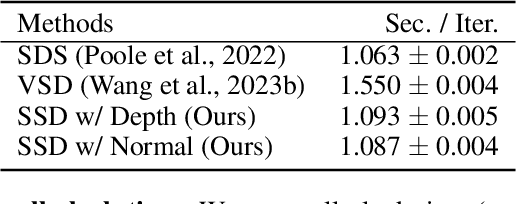
Abstract:Score distillation has emerged as one of the most prevalent approaches for text-to-3D asset synthesis. Essentially, score distillation updates 3D parameters by lifting and back-propagating scores averaged over different views. In this paper, we reveal that the gradient estimation in score distillation is inherent to high variance. Through the lens of variance reduction, the effectiveness of SDS and VSD can be interpreted as applications of various control variates to the Monte Carlo estimator of the distilled score. Motivated by this rethinking and based on Stein's identity, we propose a more general solution to reduce variance for score distillation, termed Stein Score Distillation (SSD). SSD incorporates control variates constructed by Stein identity, allowing for arbitrary baseline functions. This enables us to include flexible guidance priors and network architectures to explicitly optimize for variance reduction. In our experiments, the overall pipeline, dubbed SteinDreamer, is implemented by instantiating the control variate with a monocular depth estimator. The results suggest that SSD can effectively reduce the distillation variance and consistently improve visual quality for both object- and scene-level generation. Moreover, we demonstrate that SteinDreamer achieves faster convergence than existing methods due to more stable gradient updates.
Taming Mode Collapse in Score Distillation for Text-to-3D Generation
Dec 31, 2023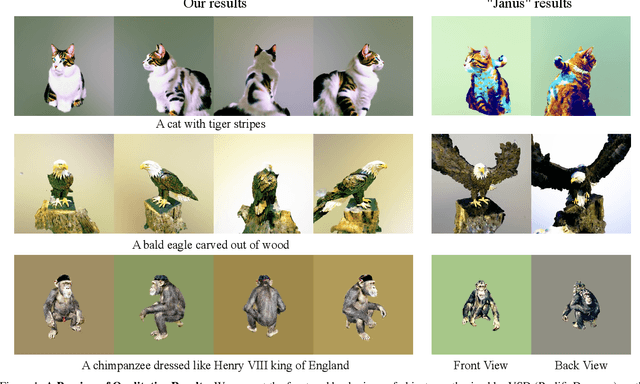
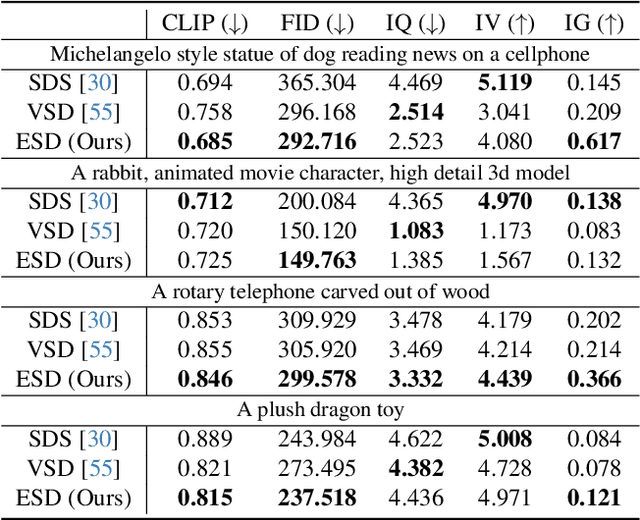


Abstract:Despite the remarkable performance of score distillation in text-to-3D generation, such techniques notoriously suffer from view inconsistency issues, also known as "Janus" artifact, where the generated objects fake each view with multiple front faces. Although empirically effective methods have approached this problem via score debiasing or prompt engineering, a more rigorous perspective to explain and tackle this problem remains elusive. In this paper, we reveal that the existing score distillation-based text-to-3D generation frameworks degenerate to maximal likelihood seeking on each view independently and thus suffer from the mode collapse problem, manifesting as the Janus artifact in practice. To tame mode collapse, we improve score distillation by re-establishing in entropy term in the corresponding variational objective, which is applied to the distribution of rendered images. Maximizing the entropy encourages diversity among different views in generated 3D assets, thereby mitigating the Janus problem. Based on this new objective, we derive a new update rule for 3D score distillation, dubbed Entropic Score Distillation (ESD). We theoretically reveal that ESD can be simplified and implemented by just adopting the classifier-free guidance trick upon variational score distillation. Although embarrassingly straightforward, our extensive experiments successfully demonstrate that ESD can be an effective treatment for Janus artifacts in score distillation.
MMG-Ego4D: Multi-Modal Generalization in Egocentric Action Recognition
May 12, 2023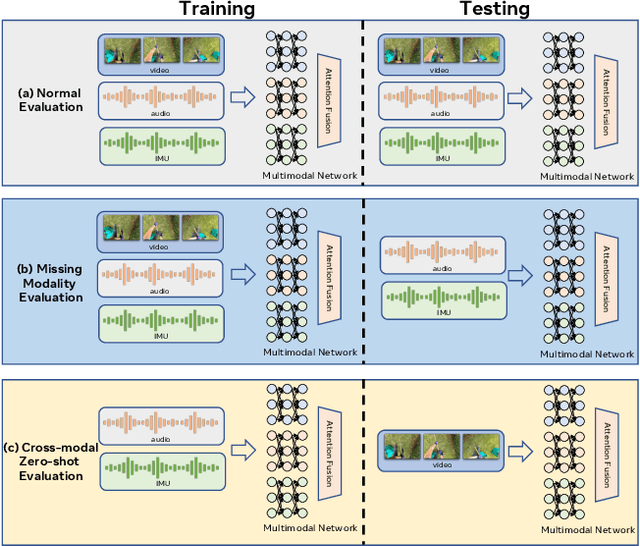

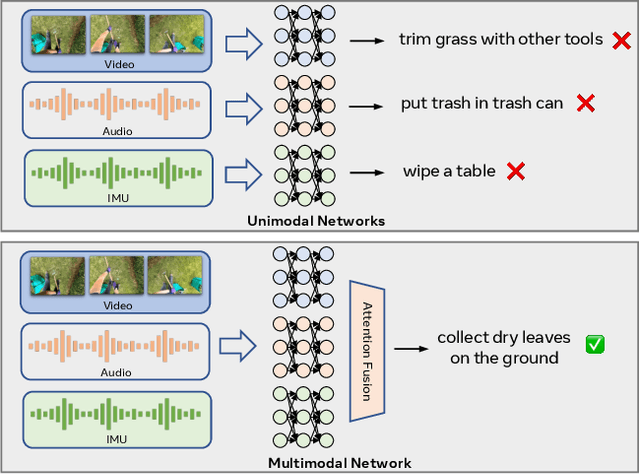

Abstract:In this paper, we study a novel problem in egocentric action recognition, which we term as "Multimodal Generalization" (MMG). MMG aims to study how systems can generalize when data from certain modalities is limited or even completely missing. We thoroughly investigate MMG in the context of standard supervised action recognition and the more challenging few-shot setting for learning new action categories. MMG consists of two novel scenarios, designed to support security, and efficiency considerations in real-world applications: (1) missing modality generalization where some modalities that were present during the train time are missing during the inference time, and (2) cross-modal zero-shot generalization, where the modalities present during the inference time and the training time are disjoint. To enable this investigation, we construct a new dataset MMG-Ego4D containing data points with video, audio, and inertial motion sensor (IMU) modalities. Our dataset is derived from Ego4D dataset, but processed and thoroughly re-annotated by human experts to facilitate research in the MMG problem. We evaluate a diverse array of models on MMG-Ego4D and propose new methods with improved generalization ability. In particular, we introduce a new fusion module with modality dropout training, contrastive-based alignment training, and a novel cross-modal prototypical loss for better few-shot performance. We hope this study will serve as a benchmark and guide future research in multimodal generalization problems. The benchmark and code will be available at https://github.com/facebookresearch/MMG_Ego4D.
Evaluating Unsupervised Denoising Requires Unsupervised Metrics
Oct 12, 2022



Abstract:Unsupervised denoising is a crucial challenge in real-world imaging applications. Unsupervised deep-learning methods have demonstrated impressive performance on benchmarks based on synthetic noise. However, no metrics are available to evaluate these methods in an unsupervised fashion. This is highly problematic for the many practical applications where ground-truth clean images are not available. In this work, we propose two novel metrics: the unsupervised mean squared error (MSE) and the unsupervised peak signal-to-noise ratio (PSNR), which are computed using only noisy data. We provide a theoretical analysis of these metrics, showing that they are asymptotically consistent estimators of the supervised MSE and PSNR. Controlled numerical experiments with synthetic noise confirm that they provide accurate approximations in practice. We validate our approach on real-world data from two imaging modalities: videos in raw format and transmission electron microscopy. Our results demonstrate that the proposed metrics enable unsupervised evaluation of denoising methods based exclusively on noisy data.
Deep Probability Estimation
Nov 21, 2021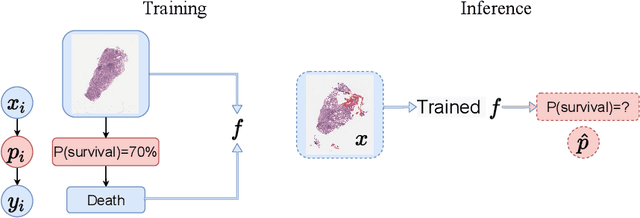
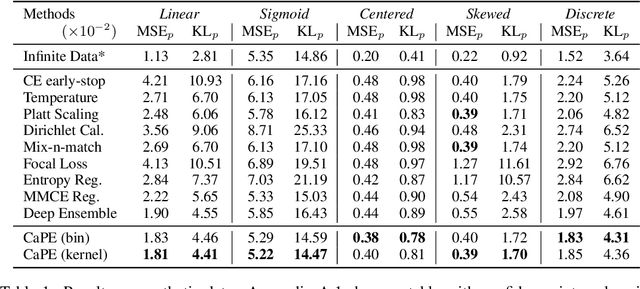

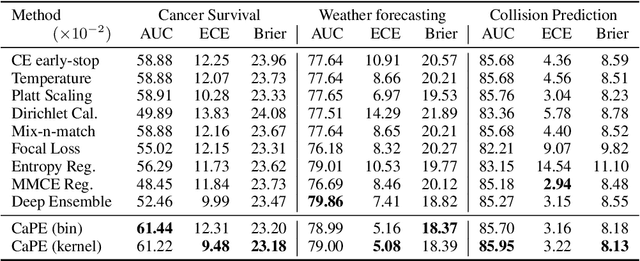
Abstract:Reliable probability estimation is of crucial importance in many real-world applications where there is inherent uncertainty, such as weather forecasting, medical prognosis, or collision avoidance in autonomous vehicles. Probability-estimation models are trained on observed outcomes (e.g. whether it has rained or not, or whether a patient has died or not), because the ground-truth probabilities of the events of interest are typically unknown. The problem is therefore analogous to binary classification, with the important difference that the objective is to estimate probabilities rather than predicting the specific outcome. The goal of this work is to investigate probability estimation from high-dimensional data using deep neural networks. There exist several methods to improve the probabilities generated by these models but they mostly focus on classification problems where the probabilities are related to model uncertainty. In the case of problems with inherent uncertainty, it is challenging to evaluate performance without access to ground-truth probabilities. To address this, we build a synthetic dataset to study and compare different computable metrics. We evaluate existing methods on the synthetic data as well as on three real-world probability estimation tasks, all of which involve inherent uncertainty: precipitation forecasting from radar images, predicting cancer patient survival from histopathology images, and predicting car crashes from dashcam videos. Finally, we also propose a new method for probability estimation using neural networks, which modifies the training process to promote output probabilities that are consistent with empirical probabilities computed from the data. The method outperforms existing approaches on most metrics on the simulated as well as real-world data.
Perturbation CheckLists for Evaluating NLG Evaluation Metrics
Sep 13, 2021
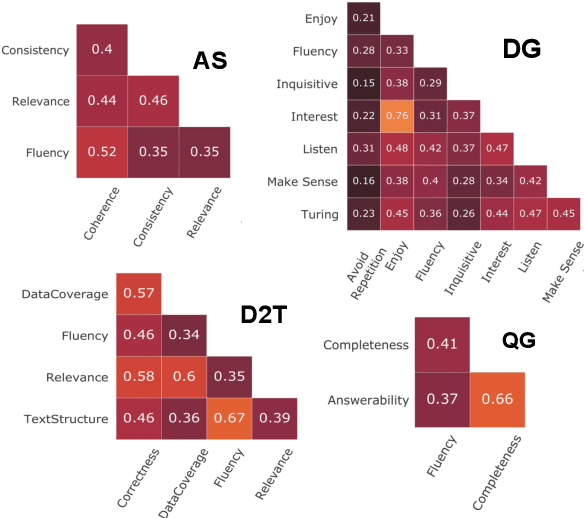
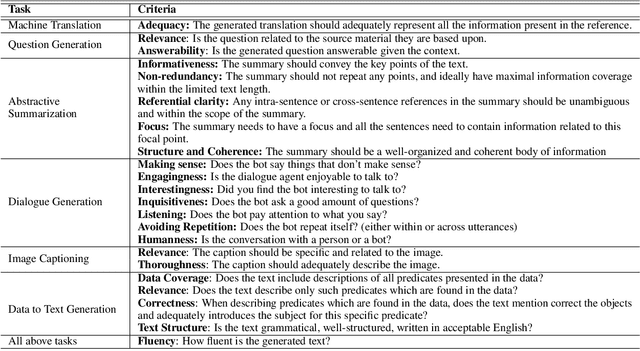
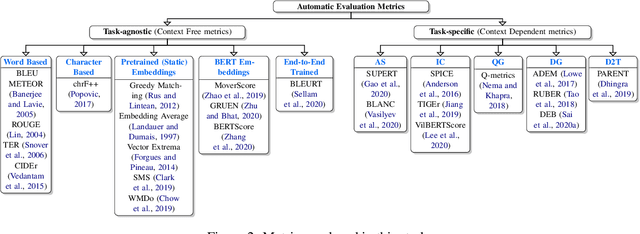
Abstract:Natural Language Generation (NLG) evaluation is a multifaceted task requiring assessment of multiple desirable criteria, e.g., fluency, coherency, coverage, relevance, adequacy, overall quality, etc. Across existing datasets for 6 NLG tasks, we observe that the human evaluation scores on these multiple criteria are often not correlated. For example, there is a very low correlation between human scores on fluency and data coverage for the task of structured data to text generation. This suggests that the current recipe of proposing new automatic evaluation metrics for NLG by showing that they correlate well with scores assigned by humans for a single criteria (overall quality) alone is inadequate. Indeed, our extensive study involving 25 automatic evaluation metrics across 6 different tasks and 18 different evaluation criteria shows that there is no single metric which correlates well with human scores on all desirable criteria, for most NLG tasks. Given this situation, we propose CheckLists for better design and evaluation of automatic metrics. We design templates which target a specific criteria (e.g., coverage) and perturb the output such that the quality gets affected only along this specific criteria (e.g., the coverage drops). We show that existing evaluation metrics are not robust against even such simple perturbations and disagree with scores assigned by humans to the perturbed output. The proposed templates thus allow for a fine-grained assessment of automatic evaluation metrics exposing their limitations and will facilitate better design, analysis and evaluation of such metrics.
Adaptive Denoising via GainTuning
Jul 27, 2021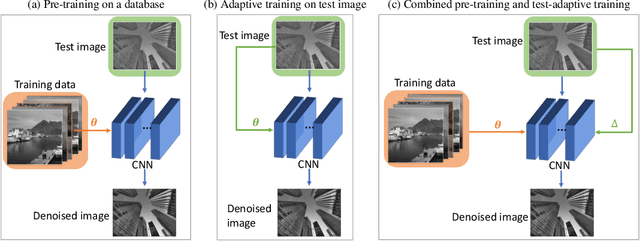
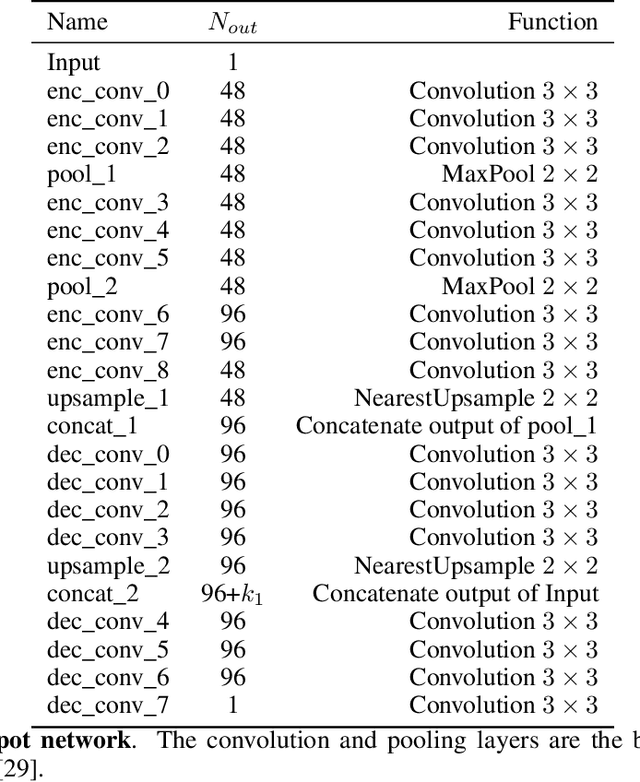
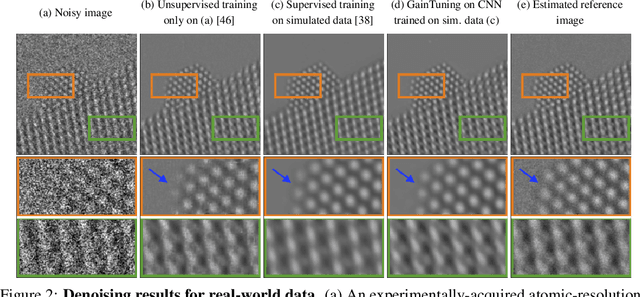

Abstract:Deep convolutional neural networks (CNNs) for image denoising are usually trained on large datasets. These models achieve the current state of the art, but they have difficulties generalizing when applied to data that deviate from the training distribution. Recent work has shown that it is possible to train denoisers on a single noisy image. These models adapt to the features of the test image, but their performance is limited by the small amount of information used to train them. Here we propose "GainTuning", in which CNN models pre-trained on large datasets are adaptively and selectively adjusted for individual test images. To avoid overfitting, GainTuning optimizes a single multiplicative scaling parameter (the "Gain") of each channel in the convolutional layers of the CNN. We show that GainTuning improves state-of-the-art CNNs on standard image-denoising benchmarks, boosting their denoising performance on nearly every image in a held-out test set. These adaptive improvements are even more substantial for test images differing systematically from the training data, either in noise level or image type. We illustrate the potential of adaptive denoising in a scientific application, in which a CNN is trained on synthetic data, and tested on real transmission-electron-microscope images. In contrast to the existing methodology, GainTuning is able to faithfully reconstruct the structure of catalytic nanoparticles from these data at extremely low signal-to-noise ratios.
 Add to Chrome
Add to Chrome Add to Firefox
Add to Firefox Add to Edge
Add to Edge